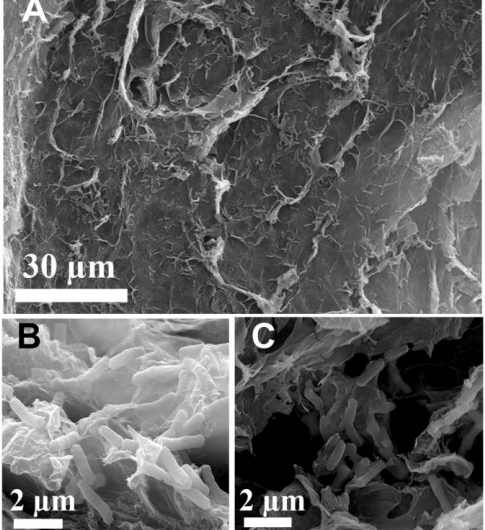November 16, 2015 report
Freestanding anode for use in helping microbial fuel cells convert waste to electricity

(Phys.org)—A team of researchers from several institutions in China has developed a freestanding anode that can be used to transfer electrolytes from bacteria in wastewater to a microbial fuel cell. In their paper published in the journal Science Advances, the team describes how they built their probe, its efficiency and their plans for improving their design.
Treating human waste is an energy intensive process, with some estimates suggesting it accounts for 3 to 5 percent of all electricity consumed in the U.S. Frustratingly, scientists have not been able to find a way to use the waste to create the electricity to treat it, in a way that is efficient enough to make it worthwhile—much of the current technology centers around fermentation and burning the methane that results, but such process are not yet efficient enough to warrant use in actual wastewater treatment facilities. Another approach is to create sewage based fuel cells which would work by pulling bacterial electrolytes off the waste and using it to create electricity—that is the approach taken by the team in China.
The new anode is based on a 3D graphene aerogel decorated with platinum nanoparticles—the team describes it as a "macroporous structure that is favorable for microorganism immobilization and efficient electrolyte transport." In the lab it looks somewhat like a lump of pumice, the porous surface offers more surface area. The team tested the probe first with water infested with Shewanella oneidensis bacteria, noting how the bacteria became lodged in the pores of the anode. They further tested it with a microbial fuel cell and wastewater samples taken from an actual wastewater treatment facility, and proved the probe worked as designed by using the resultant energy claimed from the sewage to power a small digital kitchen timer.
The research group acknowledges that their process is still not efficient enough for practical use, but suggests their probe is a demonstration of what could become a real application. Additional hurdles to overcome will include replacing the platinum with something much less expensive, and finding a way to make the probe durable enough to last for years immersed in raw sewage.
More information: S. Zhao et al. Three-dimensional graphene/Pt nanoparticle composites as freestanding anode for enhancing performance of microbial fuel cells, Science Advances (2015). DOI: 10.1126/sciadv.1500372
Journal information: Science Advances
© 2015 Phys.org











.gif)







